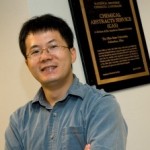WU Yiying
Department of Chemistry and Biochemistry, The Ohio State University, Columbus, Ohio 43210, USA
 Oxygen is a crucial component in emerging technologies in energy conversion and storage. For example, Li–O2 battery is regarded as one of the most promising energy storage systems for future applications. However, its energy efficiency is greatly undermined by the large overpotentials of the discharge (formation of Li2O2) and charge (oxidation of Li2O2) reactions. The parasitic reactions of electrolyte and carbon electrode induced by the high charging potential cause the decay of capacity and limit the battery life. Here, I will present our systematic investigation of a K–O2 battery that uses K+ ions to capture superoxide (O2-) to form the thermodynamically stable KO2 product. This allows for the battery to operate through the facile one-electron redox process of O2/ O2-. Without the use of catalysts, the battery shows a low discharge/charge potential gap of less than 50 mV at a modest current density. The similar idea has also been applied to Na-O2 batteries. I will also present our recent progress in “solar battery”, which possesses the dual functions of solar energy harvesting and storage in a single device. An example is 'lithium-iodine solar flow battery' that brings together a lithium–iodine redox-flow battery and a dye-sensitized photoelectrode. The photoexcited electron transfer between the photoelectrode and the iodine catholyte enables solar-assisted charging of the flow battery. Such a hybrid device has promising applications in building integrated solar harvesting/storage, solar farms and solar fuelling stations.
Oxygen is a crucial component in emerging technologies in energy conversion and storage. For example, Li–O2 battery is regarded as one of the most promising energy storage systems for future applications. However, its energy efficiency is greatly undermined by the large overpotentials of the discharge (formation of Li2O2) and charge (oxidation of Li2O2) reactions. The parasitic reactions of electrolyte and carbon electrode induced by the high charging potential cause the decay of capacity and limit the battery life. Here, I will present our systematic investigation of a K–O2 battery that uses K+ ions to capture superoxide (O2-) to form the thermodynamically stable KO2 product. This allows for the battery to operate through the facile one-electron redox process of O2/ O2-. Without the use of catalysts, the battery shows a low discharge/charge potential gap of less than 50 mV at a modest current density. The similar idea has also been applied to Na-O2 batteries. I will also present our recent progress in “solar battery”, which possesses the dual functions of solar energy harvesting and storage in a single device. An example is 'lithium-iodine solar flow battery' that brings together a lithium–iodine redox-flow battery and a dye-sensitized photoelectrode. The photoexcited electron transfer between the photoelectrode and the iodine catholyte enables solar-assisted charging of the flow battery. Such a hybrid device has promising applications in building integrated solar harvesting/storage, solar farms and solar fuelling stations.
Biosketch:
WU Yiying received his B.S. in chemical physics from the University of Science and Technology of China in 1998, and his Ph.D. in chemistry from the University of California at Berkeley in 2003 with YANG Peidong. He then did his postdoctoral research with Prof. Galen D. Stucky at the University of California, Santa Barbara, and joined the chemistry faculty at The Ohio State University in the summer of 2005.
He was promoted to associate professor with tenure in 2011 and to full professor in 2014.He has been serving as an associate editor for ACS Applied Materials and Interfaces since 2013. His group focuses on materials chemistry for energy conversion and storage. He is the inventor of the one-electron K-O2 battery and pioneered solar batteries that integrate solar harvesting with energy storage.He received Cottrell Scholar Award in 2008, NSF CAREER Award in 2010, CAPA Biomatik Distinguished Faculty Award in 2014, and Midwest Energy News “40 under 40” in 2015. His invention of K-air battery received DOE Clean Energy Prize in 2014.
Speaker:Prof.WU Yiying
Sponsor:Prof.JIN Jian
Time: 2:00p.m.June 15th
Place:A718,SINANO
downloadFile
